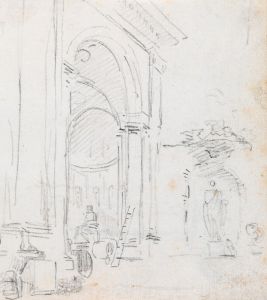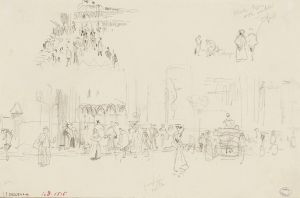
A Street in Venice
A hand-painted replica of James Abbott McNeill Whistler’s masterpiece A Street in Venice, meticulously crafted by professional artists to capture the true essence of the original. Each piece is created with museum-quality canvas and rare mineral pigments, carefully painted by experienced artists with delicate brushstrokes and rich, layered colors to perfectly recreate the texture of the original artwork. Unlike machine-printed reproductions, this hand-painted version brings the painting to life, infused with the artist’s emotions and skill in every stroke. Whether for personal collection or home decoration, it instantly elevates the artistic atmosphere of any space.
"A Street in Venice" is a painting by the American-born artist James Abbott McNeill Whistler, created in 1880. Whistler, who is best known for his innovative contributions to the art world during the late 19th century, was a key figure in the Aesthetic Movement, which emphasized the visual and sensual qualities of art over its narrative content.
Whistler's sojourn in Venice from 1879 to 1880 was a pivotal period in his career. He was commissioned by the Fine Art Society of London to produce a series of etchings and pastels of the city. This commission came at a time when Whistler was facing financial difficulties and legal troubles, notably his infamous libel suit against the art critic John Ruskin. The Venice project provided Whistler with both a creative outlet and a means to restore his reputation.
"A Street in Venice" is one of the works that emerged from this productive period. The painting captures a narrow, shadowy street in Venice, characterized by its atmospheric use of light and color. Whistler's technique in this piece reflects his interest in the interplay of light and shadow, as well as his ability to convey the mood and essence of a place through subtle tonal variations.
The composition of "A Street in Venice" is notable for its focus on the architectural elements of the street, with an emphasis on the textures and surfaces of the buildings. Whistler's use of a limited color palette, dominated by muted tones, enhances the sense of quiet and introspection that pervades the scene. The painting does not depict any human figures, which is a departure from many of Whistler's other works that often include people as part of the urban landscape. This absence of figures directs the viewer's attention to the play of light on the stone and the intricate details of the Venetian architecture.
Whistler's time in Venice was marked by his experimentation with different media and techniques. In addition to his paintings, he produced a significant number of etchings and pastels that captured the city's unique atmosphere. These works were well-received and helped to re-establish Whistler's standing in the art world. The Venice series, including "A Street in Venice," is considered a high point in Whistler's career, showcasing his ability to blend realism with a more abstract, aesthetic approach.
"A Street in Venice" is housed in the collection of the Art Institute of Chicago, where it continues to be appreciated for its artistic merit and its place within Whistler's oeuvre. The painting exemplifies Whistler's skill in capturing the essence of a place through his distinctive style, which combines a keen observational eye with a refined sense of composition and color.
Overall, "A Street in Venice" is a testament to Whistler's mastery of mood and atmosphere, and it remains an important work within the context of 19th-century art.


















